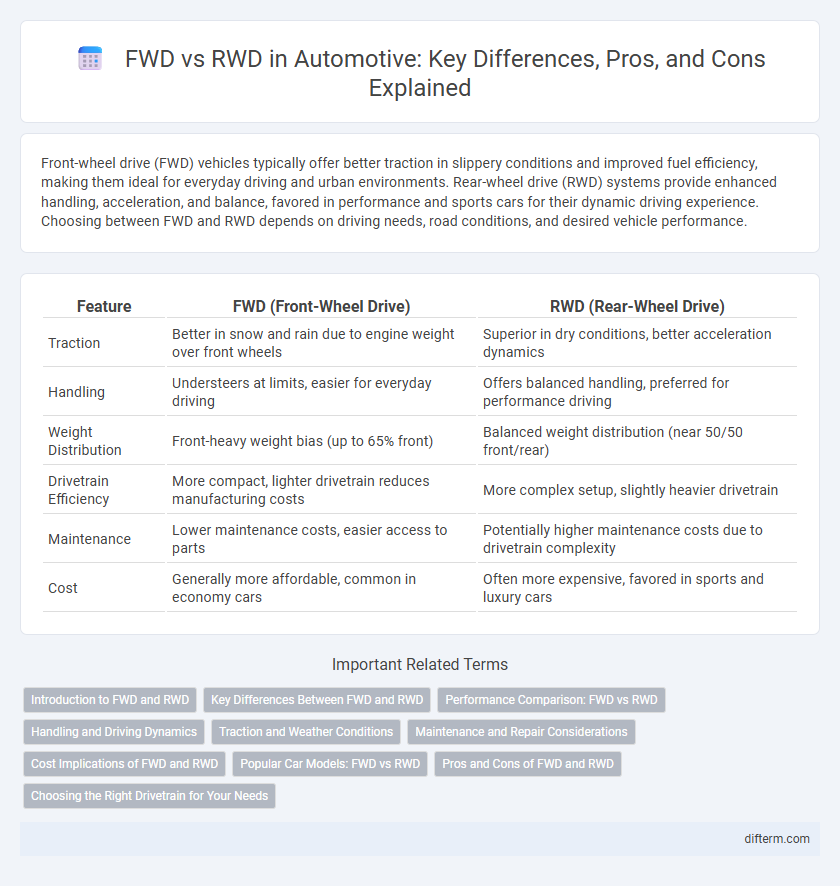Front-wheel drive (FWD) vehicles typically offer better traction in slippery conditions and improved fuel efficiency, making them ideal for everyday driving and urban environments. Rear-wheel drive (RWD) systems provide enhanced handling, acceleration, and balance, favored in performance and sports cars for their dynamic driving experience. Choosing between FWD and RWD depends on driving needs, road conditions, and desired vehicle performance.
Table of Comparison
| Feature | FWD (Front-Wheel Drive) | RWD (Rear-Wheel Drive) |
|---|---|---|
| Traction | Better in snow and rain due to engine weight over front wheels | Superior in dry conditions, better acceleration dynamics |
| Handling | Understeers at limits, easier for everyday driving | Offers balanced handling, preferred for performance driving |
| Weight Distribution | Front-heavy weight bias (up to 65% front) | Balanced weight distribution (near 50/50 front/rear) |
| Drivetrain Efficiency | More compact, lighter drivetrain reduces manufacturing costs | More complex setup, slightly heavier drivetrain |
| Maintenance | Lower maintenance costs, easier access to parts | Potentially higher maintenance costs due to drivetrain complexity |
| Cost | Generally more affordable, common in economy cars | Often more expensive, favored in sports and luxury cars |
Introduction to FWD and RWD
Front-Wheel Drive (FWD) vehicles deliver power to the front wheels, enhancing traction and fuel efficiency by combining the engine and transmission in a single unit. Rear-Wheel Drive (RWD) systems send power to the rear wheels, offering improved handling and balance, especially in performance and large vehicles. Understanding the mechanical layout and drivetrain characteristics of FWD and RWD is essential for selecting the appropriate vehicle based on driving conditions and preferences.
Key Differences Between FWD and RWD
Front-Wheel Drive (FWD) vehicles deliver power to the front wheels, enhancing fuel efficiency and providing better traction in slippery conditions due to the engine's weight over the drive wheels. Rear-Wheel Drive (RWD) systems power the rear wheels, offering superior handling and acceleration performance, particularly favored in sports and performance cars. FWD layouts typically result in lower production costs and more interior space, while RWD configurations provide improved balance and driving dynamics.
Performance Comparison: FWD vs RWD
Front-Wheel Drive (FWD) vehicles offer improved traction and fuel efficiency due to the engine's weight being over the driven wheels, enhancing performance in everyday driving and slippery conditions. Rear-Wheel Drive (RWD) provides superior handling and cornering capabilities, favored in high-performance and sports cars for balanced weight distribution and dynamic driving experience. Performance metrics such as acceleration, stability, and drivetrain efficiency distinctly highlight RWD's advantage in power delivery and FWD's strengths in cost-effective, all-weather reliability.
Handling and Driving Dynamics
Front-Wheel Drive (FWD) vehicles typically offer predictable handling with better traction during acceleration, especially in slippery conditions, due to the weight of the engine over the driving wheels. Rear-Wheel Drive (RWD) cars provide superior balance and dynamic control, delivering enhanced cornering capabilities and more precise steering response by distributing power to the rear wheels, which improves overall driving dynamics. RWD setups are favored in performance and sports cars for their ability to enable controlled oversteer and improved weight transfer during aggressive driving maneuvers.
Traction and Weather Conditions
Front-wheel drive (FWD) vehicles offer superior traction in wet or snowy weather due to engine weight over the driven wheels, enhancing grip and stability. Rear-wheel drive (RWD) systems provide better performance in dry conditions with improved handling and acceleration but can struggle with traction on slippery surfaces. Traction control systems in modern FWD and RWD vehicles help mitigate these differences, optimizing vehicle stability across various weather conditions.
Maintenance and Repair Considerations
Front-wheel drive (FWD) vehicles generally have lower maintenance costs due to fewer drivetrain components and simpler design, with most repairs centered around the transaxle and CV joints. Rear-wheel drive (RWD) systems involve more complex drivetrains, including a driveshaft and differential, which can increase repair expenses and maintenance frequency. Understanding the cost implications of parts wear such as tires, suspension components, and drivetrain lubrication is crucial when comparing FWD and RWD maintenance.
Cost Implications of FWD and RWD
Front-wheel drive (FWD) systems generally cost less to manufacture and maintain due to their simpler design and fewer drivetrain components compared to rear-wheel drive (RWD) setups. FWD vehicles benefit from reduced production expenses and improved fuel efficiency, lowering overall ownership costs. In contrast, RWD vehicles typically have higher manufacturing costs linked to complex drivetrain layouts and increased maintenance expenses over the vehicle lifespan.
Popular Car Models: FWD vs RWD
Popular FWD car models include the Honda Civic, Toyota Corolla, and Volkswagen Golf, known for their fuel efficiency and compact design, ideal for everyday commuting. Iconic RWD vehicles like the Ford Mustang, BMW 3 Series, and Mazda MX-5 Miata offer superior handling and performance, favored in sports and luxury segments. The choice between FWD and RWD often depends on driving conditions, performance needs, and vehicle type, with FWD dominating economy cars and RWD preferred for performance-focused models.
Pros and Cons of FWD and RWD
Front-wheel drive (FWD) offers improved fuel efficiency, better traction in slippery conditions, and a more compact drivetrain layout, making it ideal for everyday commuting and urban driving. Rear-wheel drive (RWD) provides superior handling, balanced weight distribution, and enhanced acceleration performance, preferred in sports cars and performance vehicles. FWD can suffer from torque steer and less dynamic handling, while RWD vehicles may experience reduced traction in adverse weather and generally come with higher manufacturing costs.
Choosing the Right Drivetrain for Your Needs
Front-Wheel Drive (FWD) vehicles offer improved fuel efficiency and better traction in slippery conditions, making them ideal for urban driving and moderate climates. Rear-Wheel Drive (RWD) provides superior handling, balance, and acceleration, favored by performance enthusiasts and drivers in dry or controlled environments. Selecting the right drivetrain depends on your typical driving conditions, desired vehicle performance, and maintenance preferences.
FWD vs RWD Infographic

 difterm.com
difterm.com